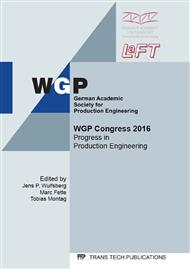p.133
p.141
p.149
p.157
p.165
p.173
p.181
p.189
p.197
Further Development of a Cutting Force Model for Gear Hobbing
Abstract:
For the process design of a cutting process, the knowledge of the cutting force is of fundamental importance. The cutting force influences the dimensioning of machine components and process parameters [1]. A precise interpretation of those process elements enables for high manufacturing and component accuracy. Due to the complexity of the chip geometries, the cutting force in gear hobbing is calculated by using a penetration calculation. The applied cutting force models have been developed by BOUZAKIS [2] and GUTMANN [3] in the 1980s. These models are based on data from longitudinal turning processes. Advancements in machine tool technology of the past decades have led to more efficient processes. The use of new cutting materials allows for higher speeds and feeds. This led to larger chip thicknesses. The bases of the models by GUTMANN and BOUZAKIS covers today's usual hobbing parameters not extensive enough. The influence of tempered levels on the cutting force is not included in the models. Therefore, the aim is to create a cutting force model and adjust the calculation base after GUTMANN. A radial turning process with interrupted cutting is used as analogy process. The influence of the heat treatment at 42CrMo4 is to be examined for the cutting force. This will be compensated in three different tensile strengths. The investigated process parameters are extended beyond the current state of the art.
Info:
Periodical:
Pages:
165-172
Citation:
Online since:
August 2016
Authors:
Keywords:
Price:
Сopyright:
© 2016 Trans Tech Publications Ltd. All Rights Reserved
Share:
Citation:


